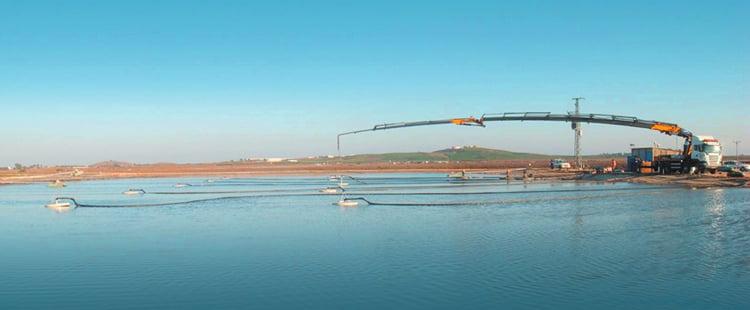For some people, the term “bubbly” evokes images of fine champagne. But for those in the wastewater treatment business, bubbles — water infused with air — are considered one of the more effective ways of treating sewage and water suffering from industrial pollution.
Bubbles are used to clean water as part of aeration systems and are considered very effective in removing pollutants and separating sludge from water, which can then be treated and released back into the environment.
Related articles
- TaKaDu: Using The Power Of Maths To Solve The World’s Water Leaks
- New Waze Feature Helps You Navigate Your Way To Clean Water
Although effective, aeration systems are not without their problems, including being limited for use in smaller, man-made pools and lagoons. In addition, they often require a lot of energy to run. But new technology from Israel’s Mapal Green Energy allows far wider deployment of aeration systems at a lower cost.
The use of bubbles to clean water has been around since the 1920s. The idea is to pump oxygen (hence the bubbles) into wastewater to enhance “aerobic digestion,” a process occurring in the presence of oxygen in which bacteria consume organic matter and convert it into carbon dioxide, which is then released into the atmosphere. The system has additional benefits, such as creating larger waste biomass in sewage, making it easier to filter water and sludge.
The problem in using aeration for water purification has been getting the oxygen into all parts of the wastewater. Traditionally, many water utilities have used mechanical aeration systems to spread the bubbles around, but these consume a great deal of energy and have high maintenance costs.
Diffusive aeration systems — in which jets push oxygen into the water — are more effective and cheaper to run but still use a lot of energy, and they can be used be used only in concrete-lined pools or lagoons no more than a few meters deep; the range of the jets is limited, and there’s little point in aerating only part of the wastewater. For the same reason, aeration cannot be used effectively on larger bodies of water, like lakes or reservoirs.
Mapal’s system solves all these problems, according to company CEO Ze’ev Fisher. Mapal’s idea is to use floating aerators that “travel” across the surface of the water, diffusing oxygen throughout the pool (up to a depth of six meters). Unlike with floating mechanical diffusers, the Mapal version has a series of tubes that extend into the water, requiring far less energy to push the oxygen into the lower depths of the water. Thus, the oxygen gets to all parts of the wastewater, ensuring that aerobic digestion can occur equally in all parts of the pool. Because the tubes can get to all parts of the wastewater, the system doesn’t need as much energy to push the oxygen out. According to studies cited by the company, its system can save as much as 70 percent of the energy used in other diffusion systems, as well as 80 percent of maintenance costs.
Mapal’s system can also dive underwater and float at different levels. This, according to Fisher, makes the system just the antidote needed for environmental emergencies, when the level of pollutants in a sewage pool, or even a lake or river, gets out of hand. The system can be deployed to attack the highest concentration of pollutants, preventing them from spreading and creating even more damage.
Mapal systems have been installed in Israel, as well as in Brazil, South Africa and India for a total of 30 locations worldwide. Now, the company has its first European contract, closing a deal with the UK’s Anglian Water to deploy its solution for a water company serving 4 million customers. Mapal’s bubble-spreaders will be installed in as many as 400 of Anglian’s 1,100 wastewater treatment facilities, the company said, adding that it is in “advanced talks” with other UK water treatment companies.
…
To continue reading this article, click here.
Via The Times of Israel
Photo by Mapal Green Energy
Related posts

Resilient And Nutritious New Plant-Based Milk Aims To Make A Splash

Chocolate From Cultivated Cocoa Comes Without Environmental Toll

Plastic Fantastic: Startup Takes PVC Back To Its Crude Oil Roots




Facebook comments